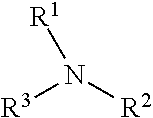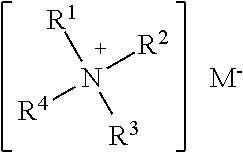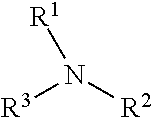Fuel additive for improved performance in fuel injected engines
a technology of fuel additives and additive concentrates, which is applied in the direction of fuels, organic chemistry, mechanical equipment, etc., can solve the problems of undesirable deposits in the fuel composition of the fuel injected engine, the dispersant is not necessarily effective direct fuel injection diesel engine, and the dispersant is not particularly effective for cleaning surfaces, etc., to achieve the effect of improving the power recovery of the engine and reducing the amount of deposits
- Summary
- Abstract
- Description
- Claims
- Application Information
AI Technical Summary
Benefits of technology
Problems solved by technology
Method used
Image
Examples
##ventive example 3
Inventive Example 3
Dimethyl Soy Amine (DMSD) with C14-Methyl Salicylate (MS14)
[0044]A. Preparation of Alkylated Methyl Salicylate. To a flask was added solid acid resin (28 g), 1-tetradecene (262 g), and methyl salicylate (102 g). The mixture was heated at 130° C. for 2.5 hours followed by 135° C. for about 10 hours. The mixture was filtered. Unreacted methyl salicylate was removed from the mixture under reduced pressure. The alkylated product (MS14) was obtained as a yellowish liquid (262 g).
[0045]B. Quaternization of DMSD with MS14. A mixture of DMSD (100 g) and MS14 (90 g, about 0.6 equivalent) was heated at 160° C. for about 5 hours to give mixture as a brownish oily liquid. The mixture was used without further purification.
##ventive example 5
Inventive Example 5
Oleylamido Propyldimethylamine with C14-Meth 1 Salicylate MS14
[0047]A mixture of oleylamidopropyl dimethylamine (OD, 85 g) made according to Example 4 and C14-Methyl Salicylate (MS 14, 103 g) made according to Part A of Example 3 was heated at 160° C. for 4 hours to give a quaternary ammonium reaction product without further purification. There was about 90% wt. of nonvolatile materials in the reaction product.
##ventive example 7
Inventive Example 7
Dimethyl ethanolamine (DMEA) with C10-Methyl Salicylate MS10
[0049]A mixture dimethyl ethanolamine (DMEA, 20 g) and decyl substituted methyl salicylate (MS10, 97 g) (prepared similarly to inventive Example 3, part A, except 1-decene was used in place of 1-tetradecene) was heated at 145° C. for 2 hours and then at 150° C. for 1 hour. The product was soluble in aromatic solvent 150.
[0050]A DW10 test that was developed by Coordinating European Council (CEC) was used to demonstrate the propensity of fuels to provoke fuel injector fouling and was also used to demonstrate the ability of certain fuel additives to prevent or control these deposits. Additive evaluations used the protocol of CEC F-98-08 for direct injection, common rail diesel engine nozzle coking tests. An engine dynamometer test stand was used for the installation of the Peugeot DW10 diesel engine for running the injector coking tests. The engine was a 2.0 liter engine having fou...
PUM
| Property | Measurement | Unit |
|---|---|---|
| molecular weight | aaaaa | aaaaa |
| pressures | aaaaa | aaaaa |
| weight | aaaaa | aaaaa |
Abstract
Description
Claims
Application Information
 Login to View More
Login to View More - R&D
- Intellectual Property
- Life Sciences
- Materials
- Tech Scout
- Unparalleled Data Quality
- Higher Quality Content
- 60% Fewer Hallucinations
Browse by: Latest US Patents, China's latest patents, Technical Efficacy Thesaurus, Application Domain, Technology Topic, Popular Technical Reports.
© 2025 PatSnap. All rights reserved.Legal|Privacy policy|Modern Slavery Act Transparency Statement|Sitemap|About US| Contact US: help@patsnap.com



